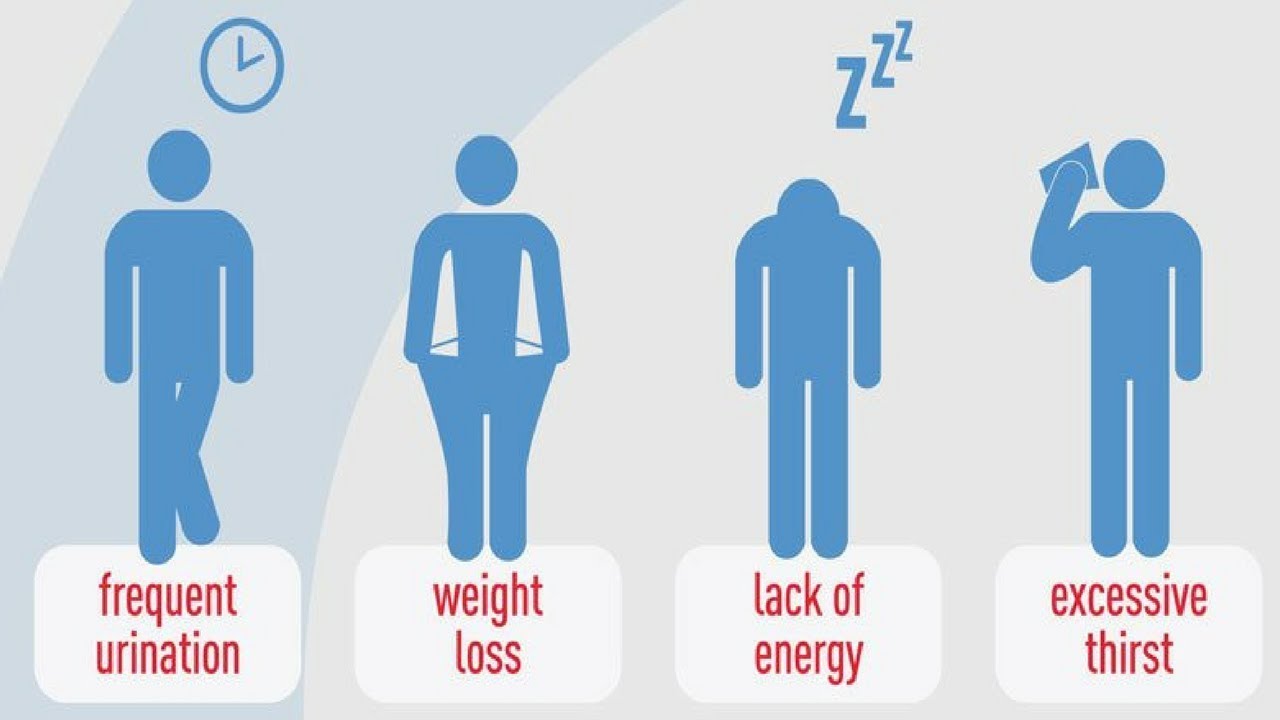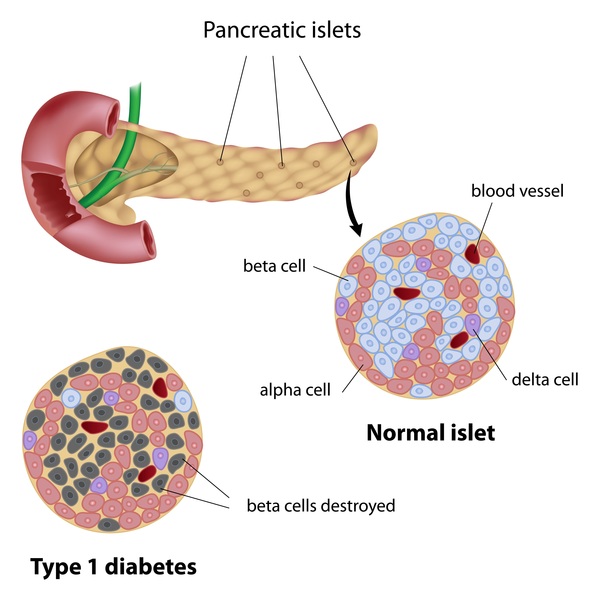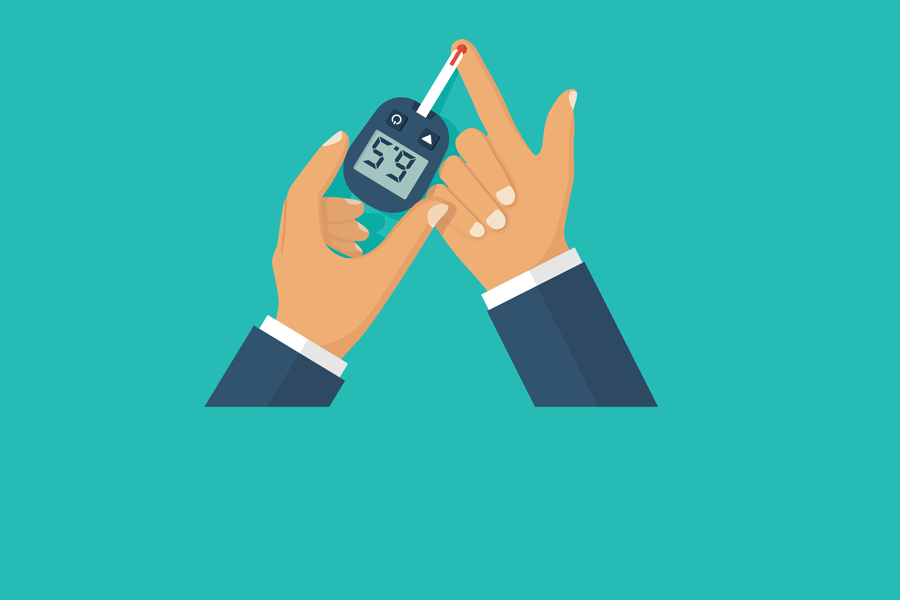Diabetes Mellitus Type 1 is a chronic condition where the body is unable to produce insulin as the weak immune system destroys the beta cells in the pancreas which are responsible for producing insulin. This alleviates the process of carrying the glucose to the body cells which are utilized to convert glucose into energy that the body requires. So the patient needs to take insulin shots lifelong in order to survive. This is why it is also known as “Insulin Dependent Diabetes”.
Type 1 Diabetes is very common in the young generation either since birth or early childhood or teenage years. Hence, it is also called as “Juvenile Diabetes”. There are a number of factors contributing to the development of this condition in the body which involve a combination of genetic and environmental factors. However, the underlying cause is the autoimmune destruction of beta cells in the pancreas.
Diabetes Mellitus Type 1 makes upto 5-10% of the estimated patients globally with 80,000 new cases every year among children and young adults.
Symptoms & Complications of Type 1 Diabetes

Here are the major symptoms that are seen in people with Type 1 Diabetes:
- Polyuria which means increased urination.
- Increased thirst which is called Polydipsia in medical terminology.
- Polyphagia, a condition of increased hunger
- Xerostomia, also known as dry mouth, due to changes in the salivary composition or reduced salivary flow
- Chronic condition of fatigue and low levels of energy along with tiredness and lethargy.
- Sudden weight loss
- Skin infections and itching
- Dizziness and blurred vision
- Headaches and mood swings
Moreover, many of the patients who suffer from Type 1 Diabetes are diagnosed with Diabetic Ketoacidosis. It is a life-threatening complication where a person suffers from vomiting, abdominal pain, deep gasping breathing, weakness, confusion, dry skin, drowsiness and loss of consciousness. In this condition, a person may develop a specific smell when he or she breathes.
Near about 12% of people suffering from Type 1 Diabetes are patients of clinical depression. Also 6% of them have Celiac Disease, a condition of long term autoimmune disorder that affects the small intestine permanently. The association of celiac disease with that of Type 1 Diabetes further increases the complications of diabetes neuropathy, diabetic retinopathy and death.
Causes Of Type 1 Diabetes

There are a number of factors that contribute to this condition and many theories have been put forth over the years. But, the causes can be one or more inclusive of the combination of genetic and environmental factors.
- Genetic Susceptibility
There are greater chances of genetic susceptibility in the cases of Type 1 Diabetes. It is about 5% of the risk from father’s side, 8% from the siblings’ side and 3% from the mother’s side on the part of developing Type 1 Diabetes. While, in case of twins, there are 40% chances that the other will develop this condition in future if in case any one of them is suffering from it.
There are more than 50 genes associated with Diabetes Mellitus Type 1 that can be dominant, recessive or in between both. This depends on the locus or the combination of loci.
- Other Environmental Factors
Environmental factors may include intake of selective drugs and chemicals that lead to destruction of beta cells in the pancreas. Other pancreatic problems include pancreatitis (a condition of inflammation in pancreas) which results in infections, trauma and tumors in pancreas. This leads to loss of insulin due to destruction of beta cells.
Preventive Measures

There are certain preventive measures that can be undertaken to avoid such a condition. The preventive measures have been divided into three levels namely- Primary, Secondary and Tertiary Level.
1. Primary Level
Primary prevention generally takes place in the first 3 years of life where attempts are made soon after birth if there is Type 1 diabetes in the family history. There is a need to avoid environmental risk factors and identification of viral causes that might lead to vaccination against it. Complete exclusion of cow’s milk in early infancy can definitely help reduce the risk of developing Type 1 Diabetes.
2. Secondary Level
This is to be applied when the individuals are at the increased risk of progression to Type 1 Diabetes. They are identified by metabolic testing that looks into the family history, additional measurement of first phase of insulin secretion and glucose tolerance with antibodies. Altogether, this helps to identify those who are at the imminent risk of progression in diabetes so that suitable changes can be made in the diet and lifestyle.
3. Tertiary Level
At this level, the functional beta cell mass is the main key which allows the individuals to enter into this condition, thereby stopping the insulin altogether for weeks or months. So preservation of beta cell mass proves beneficial in this condition in terms of better control over the glucose levels in the blood and also for avoidance of hypoglycemia.
These were the different levels at which the condition can be detected early with the onset of diabetes. This helps to keep a check on the metabolic activities of the body which further aids in making suitable changes in the lifestyle to avoid the occurrence of Type 1 Diabetes.
What Is The Cure?

People who are suffering from Type 1 Diabetes invite a lot of additional complications which may get worse when they are not treated in a right way. Cure for Type 1 Diabetes has two aspects. Firstly, there is a need to stop the attack of immune system on insulin-producing beta cells and encapsulate new beta cells from further attack. Secondly, there is a need to focus on body’s own ability to produce insulin, either by making new beta cells or by other remaining healthy cells in the pancreas.
Diabetes cure is a long-term process which is carried in certain ways such as:
1. Insulin Injections
Insulin injections are one of the most common ways of treating Type 1 Diabetes. It comes as a shock initially for most of the people but gradually it becomes an inevitable part of their life that contributes to the management of their blood sugar levels in the body.
2. Insulin Pumps
It is another way of reducing the problem involved in curing diabetes through insulin injections. It works on insulin infusion therapy that continuously delivers small amount of insulin through insulin pumps in the fat layers under the skin through a tube called cannula, where it can be absorbed by the blood.
3. Monitoring Glucose Levels In The Blood
It is very important to keep a check on the glucose levels in the body just to ensure that they are within the blood glucose targets. Although balancing the blood sugar is not too easy, but keeping it in range i.e. not to high or not too low will help you gain insight of your body mechanism and how your diabetes behaves. Altogether, this helps in recognizing the symptoms of high or low blood sugar and helps to manage it effectively.
4. The Honeymoon Phase
When an individual is detected with Type 1 Diabetes, the body still produces some useful amount of insulin which is called as the honeymoon phase. It is slightly easy to manage sugar levels with the help of the little insulin that the pancreas produces.
5. Diet And Sugar Levels
Insulin helps to lower down the glucose level in the blood but the diet which we follow also plays a significant role in managing our blood sugar levels. It is advised to take a diet with less carbohydrates as it breaks down the food into glucose and carries it to the blood streams which raises the blood sugar levels in the body.
6. Genetic And Cellular Engineering
In this type of approach, the beta cells are engineered to evade the immune system to hinder the process of antibody development. This helps in avoiding the condition of hypoglycemia.
7. Bioartificial Pancreas
These contain living cells in an artificial matrix comprising of different polymers harvested from living donors or animals. The primary islets or cells form an essential component of the matrix for Bioartificial Pancreas.
So, these were some of the approaches that can be undertaken for the effective management of diabetes. This simply encourages healthy and happy living.

